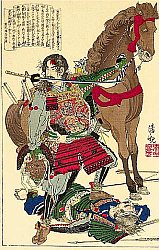Samurai is the word for a Japanese warrior class and for a member of this class. Samurai warriors have been glorified in numerous films, books, comic series, TV shows and theater plays. The Samurai history is a source of fascination for adults and children all over the world.
The Origins of Japanese Samurai
The Japanese samurai warriors came into existence in the 12th century when two powerful Japanese clans fought bitter wars against each other - the Taira and the Minamato. At that time the Japanese shogunate, a system of a military ruler, called the shogun was formed. Under the shogun the next hierarchy were the daimyo, local rulers comparable to dukes in Europe. The Japanese samurai were the military retainers of a daimyo. And finally you may have heard of ronin. Ronin are samurai without a master. This is what happened to the 47 Ronin in the famous story of Chushingura after their lord was forced to commit suicide.
According to historians the fierce fights between hostile clans and war lords was mainly a battle for land. Only 20 percent of Japan's rugged and mountainous area can be used for agriculture.
Attributes and Privileges
 |
| Samurai on Horse |
| by Keishu Takeuchi 1861-1942 |
Samurai warriors had several privileges. They were allowed to wear two swords - a long one and a short one. Commoners were not allowed to wear any weapons at all. At a certain period samurai warriors were even allowed to behead a commoner who had offended them.
The Japanese samurai caste itself had different ranks with different privileges. A basic ranking system from the twelfth century distinguished three major ranks:
- kenin - meaning "housemen". They were the administrators or vassals.
- mounted samurai - Only high-ranking samurai warriors were allowed to fight on horse-back.
- foot soldiers
During the end of the 15th century, the Ashikaga shogunate had lost control over the country. Powerful feudal lords had ravaged Japan in a series of civil wars lasting for roughly 100 years. When Toyotomi Hideyoshi could finally unify Japan, he introduced a series of reforms thus changing the life of the samurai class. He made the samurai live permanently in castles. Until then they were farming their own land during peacetime. It was like the change from an army of draftees to an army of professionals. To finance the system, Toyotomi Hideyoshi introduced a rice taxation system under which every samurai warrior received a certain amount of rice depending on his rank.
The samurai warriors had an ethic code of behavior called bushido, meaning "way of the warrior". The central point of the bushido was complete loyalty towards the lord, the daimyo.
Belonging to the Japanese samurai class was a hereditary membership.
